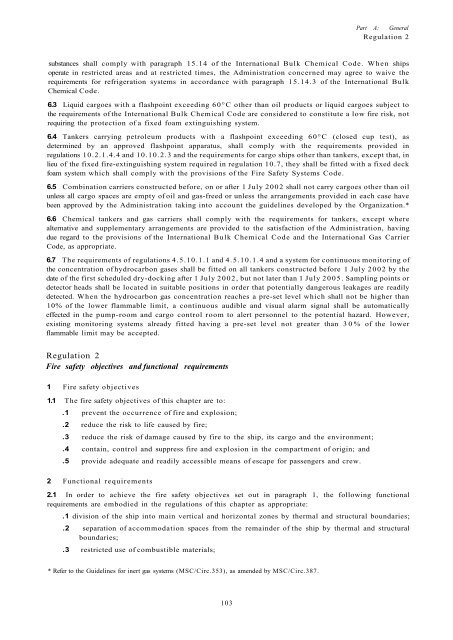Solas Consolidated Edition 2009.pdf
Solas Consolidated Edition 2009 for maritime
Solas Consolidated Edition 2009 for maritime
Create successful ePaper yourself
Turn your PDF publications into a flip-book with our unique Google optimized e-Paper software.
Part A: General<br />
Regulation 2<br />
substances shall comply with paragraph 15.14 of the International Bulk Chemical Code. When ships<br />
operate in restricted areas and at restricted times, the Administration concerned may agree to waive the<br />
requirements for refrigeration systems in accordance with paragraph 15.14.3 of the International Bulk<br />
Chemical Code.<br />
6.3 Liquid cargoes with a flashpoint exceeding 60°C other than oil products or liquid cargoes subject to<br />
the requirements of the International Bulk Chemical Code are considered to constitute a low fire risk, not<br />
requiring the protection of a fixed foam extinguishing system.<br />
6.4 Tankers carrying petroleum products with a flashpoint exceeding 60°C (closed cup test), as<br />
determined by an approved flashpoint apparatus, shall comply with the requirements provided in<br />
regulations 10.2.1.4.4 and 10.10.2.3 and the requirements for cargo ships other than tankers, except that, in<br />
lieu of the fixed fire-extinguishing system required in regulation 10.7, they shall be fitted with a fixed deck<br />
foam system which shall comply with the provisions of the Fire Safety Systems Code.<br />
6.5 Combination carriers constructed before, on or after 1 July 2002 shall not carry cargoes other than oil<br />
unless all cargo spaces are empty of oil and gas-freed or unless the arrangements provided in each case have<br />
been approved by the Administration taking into account the guidelines developed by the Organization.*<br />
6.6 Chemical tankers and gas carriers shall comply with the requirements for tankers, except where<br />
alternative and supplementary arrangements are provided to the satisfaction of the Administration, having<br />
due regard to the provisions of the International Bulk Chemical Code and the International Gas Carrier<br />
Code, as appropriate.<br />
6.7 The requirements of regulations 4.5.10.1.1 and 4.5.10.1.4 and a system for continuous monitoring of<br />
the concentration of hydrocarbon gases shall be fitted on all tankers constructed before 1 July 2002 by the<br />
date of the first scheduled dry-docking after 1 July 2002, but not later than 1 July 2005. Sampling points or<br />
detector heads shall be located in suitable positions in order that potentially dangerous leakages are readily<br />
detected. When the hydrocarbon gas concentration reaches a pre-set level which shall not be higher than<br />
10% of the lower flammable limit, a continuous audible and visual alarm signal shall be automatically<br />
effected in the pump-room and cargo control room to alert personnel to the potential hazard. However,<br />
existing monitoring systems already fitted having a pre-set level not greater than 30% of the lower<br />
flammable limit may be accepted.<br />
Regulation 2<br />
Fire safety objectives and functional requirements<br />
1 Fire safety objectives<br />
1.1 The fire safety objectives of this chapter are to:<br />
.1 prevent the occurrence of fire and explosion;<br />
.2 reduce the risk to life caused by fire;<br />
.3 reduce the risk of damage caused by fire to the ship, its cargo and the environment;<br />
.4 contain, control and suppress fire and explosion in the compartment of origin; and<br />
.5 provide adequate and readily accessible means of escape for passengers and crew.<br />
2 Functional requirements<br />
2.1 In order to achieve the fire safety objectives set out in paragraph 1, the following functional<br />
requirements are embodied in the regulations of this chapter as appropriate:<br />
.1 division of the ship into main vertical and horizontal zones by thermal and structural boundaries;<br />
.2 separation of accommodation spaces from the remainder of the ship by thermal and structural<br />
boundaries;<br />
.3 restricted use of combustible materials;<br />
* Refer to the Guidelines for inert gas systems (MSC/Circ.353), as amended by MSC/Circ.387.<br />
103


